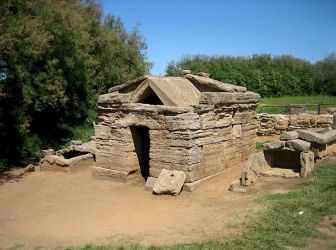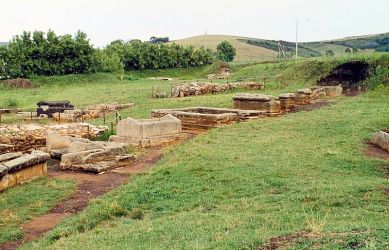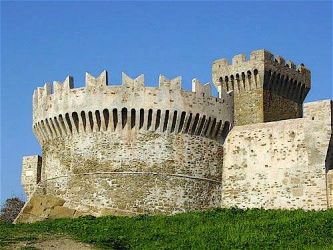Populonia
Populonia is one of the few Etruscan towns to have been founded right on the sea. It was also the largest ancient centre on the Mediterranean specialised in the smelting of iron. The ore was mined nearby on Elba. Populonia is situated on the top of a hill at the north end of the peninsular of Monte Massoncello, north of Piombino, with the sea almost all around. The Etruscan necropolis at Populonia is one of the most important in Italy.
Populonia was originally allied with Volterra, another important Etruscan city, but later became a flourishing independent mining centre and seaport. The harbour continued to be important after the decline of Etruscan power and the Populonia was still an episcopal See in the 6 C. It was destroyed in 570 by the Lombards and the few survivors, led by bishop St. Cerbo, fled to Elba.
Considerable remains of the town walls remain, composed of large, irregular, roughly rectangular blocks (the form is that of the natural splitting of the schistose sandstone), forming a perimeter of about 2.5 km. The remains existing within the walls are entirely Roman - a row of vaults, a water reservoir and a mosaic with representations of fishes. Strabo mentions the existence here of a lookout tower for spotting the shoals of tuna. There are tombs outside the town, some of which, ranging from the Villanovian period (9th century BC) to the middle of the 3rd century BC, were explored in 1908. In one, a large circular tomb, three sepulchral couches of stone carved in imitation of wood and a fine statuette in bronze of Ajax committing suicide were discovered. A horse collar with fourteen bronze bells was found nearby.
The remains of a temple, destroyed in ancient times (possibly by Dionysius of Syracuse in 384 BC) were also discovered, together with fragments of Attic vases of the 5th century BC. The iron mines of Elba and the tin and copper of the mainland, were owned and smelted by the people of Populonia. Hot springs (Aquae Populaniae) lay some 10 km to the east on the Via Aurelia running along the coast. At this point, a road branched off to Saena (Siena). According to Virgil, the Populonia sent a contingent to assist Aeneas, and it furnished Scipio the Elder with iron in 205 BC. Populonia offered considerable resistance to Sulla, who took it by siege, and its decline followed this event. Strabo notes this and four centuries later Rutilius Claudius Namatianus describes Populonia as being in ruins.
Populonia was originally allied with Volterra, another important Etruscan city, but later became a flourishing independent mining centre and seaport. The harbour continued to be important after the decline of Etruscan power and the Populonia was still an episcopal See in the 6 C. It was destroyed in 570 by the Lombards and the few survivors, led by bishop St. Cerbo, fled to Elba.
Considerable remains of the town walls remain, composed of large, irregular, roughly rectangular blocks (the form is that of the natural splitting of the schistose sandstone), forming a perimeter of about 2.5 km. The remains existing within the walls are entirely Roman - a row of vaults, a water reservoir and a mosaic with representations of fishes. Strabo mentions the existence here of a lookout tower for spotting the shoals of tuna. There are tombs outside the town, some of which, ranging from the Villanovian period (9th century BC) to the middle of the 3rd century BC, were explored in 1908. In one, a large circular tomb, three sepulchral couches of stone carved in imitation of wood and a fine statuette in bronze of Ajax committing suicide were discovered. A horse collar with fourteen bronze bells was found nearby.
The remains of a temple, destroyed in ancient times (possibly by Dionysius of Syracuse in 384 BC) were also discovered, together with fragments of Attic vases of the 5th century BC. The iron mines of Elba and the tin and copper of the mainland, were owned and smelted by the people of Populonia. Hot springs (Aquae Populaniae) lay some 10 km to the east on the Via Aurelia running along the coast. At this point, a road branched off to Saena (Siena). According to Virgil, the Populonia sent a contingent to assist Aeneas, and it furnished Scipio the Elder with iron in 205 BC. Populonia offered considerable resistance to Sulla, who took it by siege, and its decline followed this event. Strabo notes this and four centuries later Rutilius Claudius Namatianus describes Populonia as being in ruins.
In addition to the Etruscan remains, Populonia has a massive fortress built in the 15 C by the Appiani lord Jacopo II of Piombino, using stone taken from Etruscan ruins. The fort was built as a defence against pirates who infested the waters along this coast. The views from the fort over the Baratti gulf are spectacular and the small mediaeval village within the walls is worth a brief visit.



